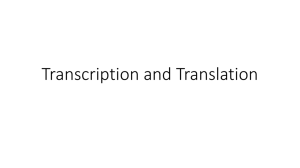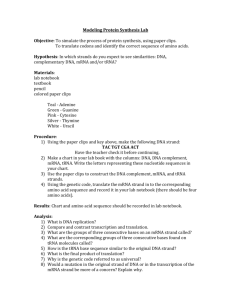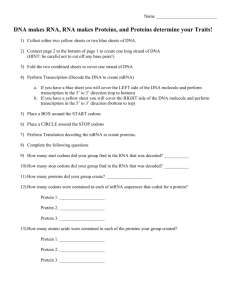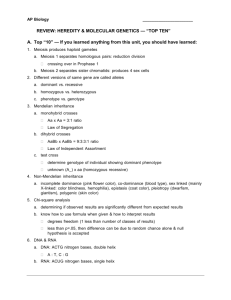Unit 5 Cell Growth and Reproduction note guide
advertisement
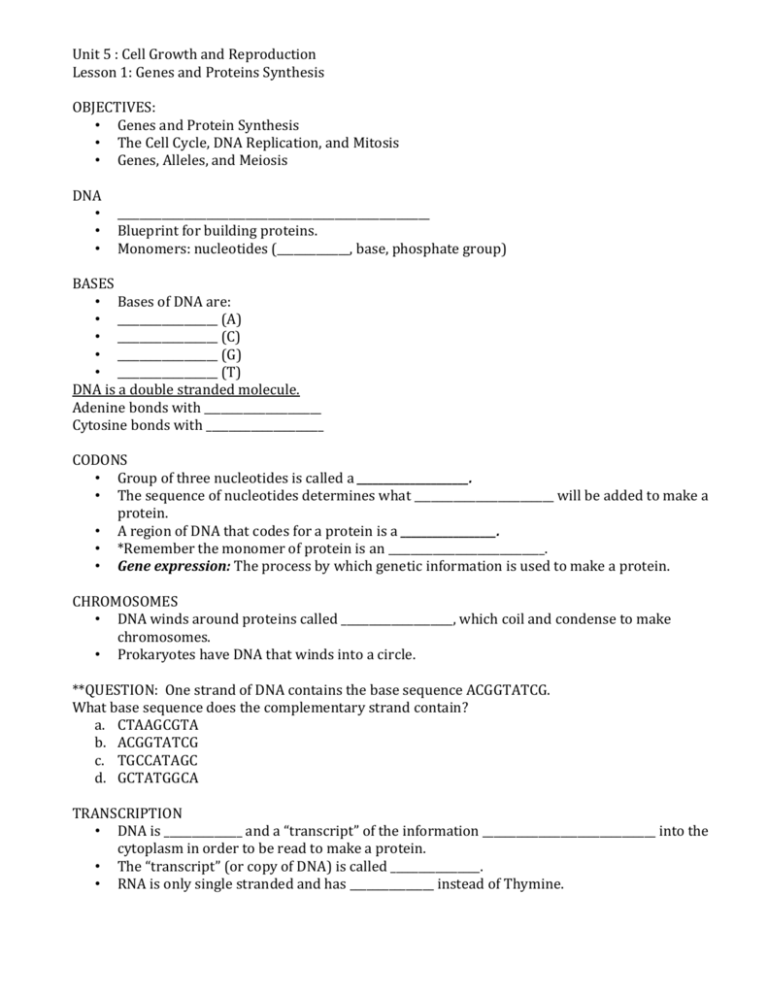
Unit 5 : Cell Growth and Reproduction Lesson 1: Genes and Proteins Synthesis OBJECTIVES: • Genes and Protein Synthesis • The Cell Cycle, DNA Replication, and Mitosis • Genes, Alleles, and Meiosis DNA • • • ________________________________________________________ Blueprint for building proteins. Monomers: nucleotides (_____________, base, phosphate group) BASES • Bases of DNA are: • __________________ (A) • __________________ (C) • __________________ (G) • __________________ (T) DNA is a double stranded molecule. Adenine bonds with _____________________ Cytosine bonds with _____________________ CODONS • Group of three nucleotides is called a _____________________. • The sequence of nucleotides determines what _________________________ will be added to make a protein. • A region of DNA that codes for a protein is a __________________. • *Remember the monomer of protein is an ____________________________. • Gene expression: The process by which genetic information is used to make a protein. CHROMOSOMES • DNA winds around proteins called ____________________, which coil and condense to make chromosomes. • Prokaryotes have DNA that winds into a circle. **QUESTION: One strand of DNA contains the base sequence ACGGTATCG. What base sequence does the complementary strand contain? a. CTAAGCGTA b. ACGGTATCG c. TGCCATAGC d. GCTATGGCA TRANSCRIPTION • DNA is ______________ and a “transcript” of the information _______________________________ into the cytoplasm in order to be read to make a protein. • The “transcript” (or copy of DNA) is called ________________. • RNA is only single stranded and has _______________ instead of Thymine. TRANSCRIPTION CONT.. • RNA (ribonucleic acid) • Transcription : process when _________________________ into a strand of mRNA. (____________________ RNA) • Steps to Transcription: • 1. _________________________________ the two strands of DNA. • 2. One strand of DNA is transcribed into _________________. • 3. RNA _________________________ (protein) attaches the correct RNA nucleotide to build the strand of mRNA. TRANSLATION • • • • There are ___________ different amino acids that make up proteins. The order of amino acids in a protein determines the protein’s 3-d _______________________________. Translation: process of ____________________________ from mRNA. Proteins are made in the ____________________________________. TRANSLATION CONT.. • Ribosomes contain rRNA (___________________ RNA) and protein. • Steps to Translation: • 1. mRNA attaches to a ribosome. • 2. The ribosome reads the mRNA and tRNA (________________ RNA) will transfer the correct amino acid onto the chain to build a protein. • 3. The ______________________ is the region on tRNA that is complementary to the codon found on the mRNA. • Ex. UGG is the codon for the amino acid tryptophan. A tRNA molecule that binds to tryptophan has the complementary anticodon sequence ACC. TRANSLATION CONT.. • There are “____________” codons and “stop” codons that helps the tRNA determine where to start building a __________________ and where to stop. ****QUESTION Amino Acid Anticodon Serine AGA Valine CAA Leucine GAU What mRNA sequence was used to make a polypetide strand of serine, valine, and leucine? Protein Synthesis in the Cell • Proteins are made on ______________________________. • Ribosomes are either ___________________________ or are free floating in the cytoplasm. • If the protein is being made for the plasma membrane they will be made on the rER. • If protein is being made for the cell to use they will be made on free ribosomes. • The protein made on rER will be packed into ____________________. • These vesicles will travel to the ____________________________, then will be modified and sent to the cell membrane. ***QUESTION • Which organelle is not involved in the synthesis and secretion of a protein from the cell? • A. Ribosome • B. Smooth ER • C. Golgi apparatus • D. Plasma membrane ASSIGNMENT – KEYSTONE PACKET • Complete ques. 1-6 • Pg. 112 & 113

